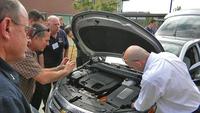-
Walden University offers M.S. in Emergency Management
The school says that this new online master’s degree program emphasizes key skills related to creating and implementing disaster prevention and response plans
-
-
On-demand emergency responder training
New service allows fire, police, EMS, and military to provide their training video library through an on-demand delivery to any television; the service allows responders to select a video through a graphical menu on the television screen and then play, pause, restart, rewind or fast forward the video
-
-
Web-based interactive solution for first responders
DGI is adding a Web-based, interactive map drawing feature to its CoBRA WEB Mapping; the solution will initially target fire departments, EMS organizations, bomb squads, HAZMAT teams, and police departments as a situational awareness tool to assist in the collaboration of first responders and emergency operation centers
-
-
New cloud computing based disaster management system
Natural and man-made disasters require an effective and efficient management of massive amounts of data and coordination of wide varieties of people and organizations; researchers develop an elaborate cloud computing-based disaster management system
-
-
Smartphones to save lives in natural disasters

Smartphones could help save hundreds of thousands of lives in the aftermath of a disaster or humanitarian crisis; software developed by computer scientists could help quickly and accurately to locate missing people, rapidly identify those suffering from malnutrition and effectively point people towards safe zones simply by checking their phones
-
-
Simulations help firefighters in risky operations

Firefighters often put their lives at risk during operations, so it would be very helpful if they had reliable tools to help them do their job safely and effectively; now, a modular simulation kit is set to help develop new information and communication technologies — and ensure they are tailored to firefighters’ needs from the outset.
-
-
NY counties receive money to prepare for emergencies
The magnitude of Hurricane Irene and Tropical Storm Lee posed serious communications challenges to the response and recovery efforts among many New York counties; these counties are now receiving $20 million in funding to help localities better respond to emergency situations
-
-
Georgia readies portable hospitals
On Monday local health and emergency response officials from Georgia’s West Central Health District gathered to learn how to quickly set up a portable hospital in the event of an emergency
-
-
Measuring the effect of fire on materials
Researchers at Universidad Carlos III de Madrid (UC3M) are developing an infrared measuring method to analyze the thermal properties and resistance to fire of composite materials; this advance would have applications in areas where fire safety requires that the composite materials withstand high temperatures
-
-
Key to disaster preparedness is “training, training, training”

Bonnie S. Michelman, CPP/CHPA, the director of police, security, and outside services at Massachusetts General Hospital, recently took the time to speak with Homeland Security NewsWire’s executive editor Eugene K. Chow; in their interview, Michelman highlights the recent technological security measures Massachusetts General has installed, finding the right balance between security and openness, and preventing terrorists from stealing the low-grade radioactive materials that are housed in hospitals
-
-
Water rescues prove dangerous for first responders
Water rescues are particularly dangerous for first responders, and the recent attempt to rescue a man who jumped from a bridge over the Oswego River in New York last month proved to be no exception
-
-
Grant helps Kentucky dive team operate without sight
Rescue and recovery divers often struggle to perform their duties in murky, muddy waters, but thanks to a $21,000 grant from Kentucky’s Homeland Security department, the city of Grayson was able to purchase a side-scan sonar and an underwater metal detector to help rescue divers complete their mission in low visibility conditions
-
-
New sensor system tracks, locate firefighters where GPS fails
With support from the National Science Foundation, electrical engineers are developing a portable device called the Sentrix Tracking Unit; it straps on like a belt and consists of a suite of sensors; the sensors help locates missing firefighters— saving time and maybe lives
-
-
First responders learn how to deal with electric cars

With the growing number of electric vehicles on the road, first responders are now faced with a new type of vehicle that they know little about, which could be potentially dangerous in the event of a fatal crash; to help emergency responders learn about the new technology on the road today, Tesla, a manufacturer of electric vehicles, recently held a training seminar at one of its locations in California
-
-
Disaster evacuation plans need to incorporate family perspectives
A recent study sponsored by the National Science Foundation found that most respondents felt the evacuation of New Orleans residents to the Superdome after Hurricane Katrina was a “failure” and this opinion has shaped their willingness to accept shelter if offered in an emergency evacuation
-
- All
- Regional
- Water
- Biometrics
- Borders/Immig
- Business
- Cybersecurity
- Detection
- Disasters
- Government
- Infrastructure
- International
- Public health
- Public Safety
- Communication interoperabillity
- Emergency services
- Emergency medical services
- Fire
- First response
- IEDs
- Law Enforcement
- Law Enforcement Technology
- Military technology
- Nonlethal weapons
- Nuclear weapons
- Personal protection equipment
- Police
- Notification /alert systems
- Situational awareness
- Weapons systems
- Sci-Tech
- Sector Reports
- Surveillance
- Transportation
Advertising & Marketing: advertise@newswirepubs.com
Editorial: editor@newswirepubs.com
General: info@newswirepubs.com
2010-2011 © News Wire Publications, LLC News Wire Publications, LLC
220 Old Country Road | Suite 200 | Mineola | New York | 11501
Permissions and Policies
Editorial: editor@newswirepubs.com
General: info@newswirepubs.com
2010-2011 © News Wire Publications, LLC News Wire Publications, LLC
220 Old Country Road | Suite 200 | Mineola | New York | 11501
Permissions and Policies
